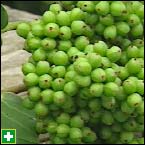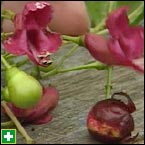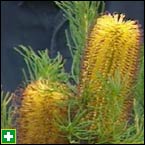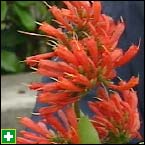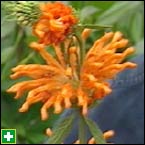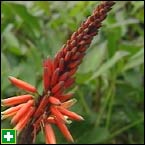Berries, blossoms and birdsBring the birds into your garden with these winter flowering, berry producing plants. Native plants in the winter garden are fantastic, not just for tarting up a bare backyard, but also for providing for the birds. The puka (Meryta sinclairii), for example, is laden with berries at the moment and, although not quite ripe yet, will be a great source of food for the birds in a month or two. The titoki (Alectryon
excelcus) is also a favourite with our feathered friends, as
is the puriri (Vitex lucens). The puriri, which comes into
flower right through the year, should have some nice, plump berries
about now. It's a large tree — 10m plus high and 5m wide —
but if you've got the room, it's well worth it for its pink flowers
and red berries. For nectar-rich plants, try the banksia. A wonderful family — Australian native plants. Banksias range from trees to ground covers, and this particular species is a ground cover. It's a prostrate mat of grey-green leaves, called Banksia gardneri. These inflorescences come up above that foliage.
There's also a wide range of South African plants such as the protea which obligingly flower at this time of year. They're excellent for the coast, and they're pretty much the ultimate bird-attractant plant. As proteas are coming into flower now, it's a great time to see what new varieties are available. Choose something that's really bushy, as they flower on the current season's wood — the flower head will come there. There are some other South African plants that are not so well known. This is Alberta magna. Look at that stunning colour — a real attraction for the birds. If a plant has a bright-red flower, it's a plant that's trying to attract birds. The Alberta magna, or Natal flame bush, grows best in areas with humid or moist climates; it doesn't like dry heat or cold. It grows well in coastal areas.
Another plant that won't do too well in frosts but grows well indoors is the strelitzia. It's grown indoors in Wellington, for example. But the birds damage the plant a bit, because the nectar is right down inside the flower. Often birds, when they feed on flowers, really savage those flowers. But the strelitzia is a good example of a really bird-attractant plant. Lovely cut flower as well.
|
Home | Journal
| Newsletter | Conferences
Awards | Join
RNZIH | RNZIH Directory | Links
© 2000–2024 Royal New Zealand Institute of Horticulture
Last updated: June 2, 2004


